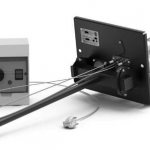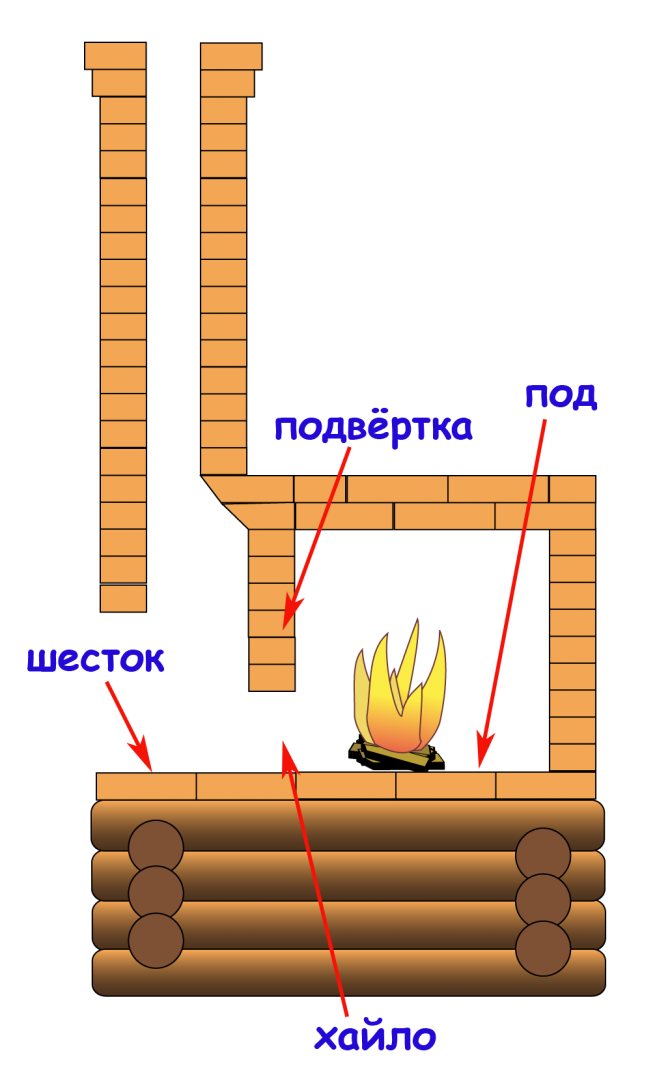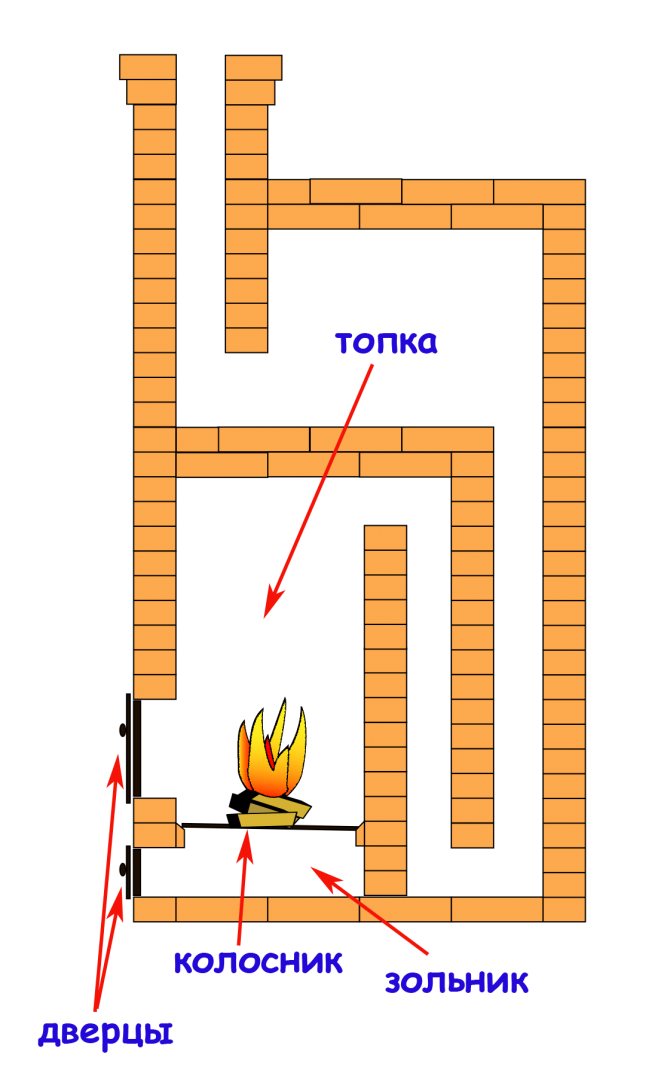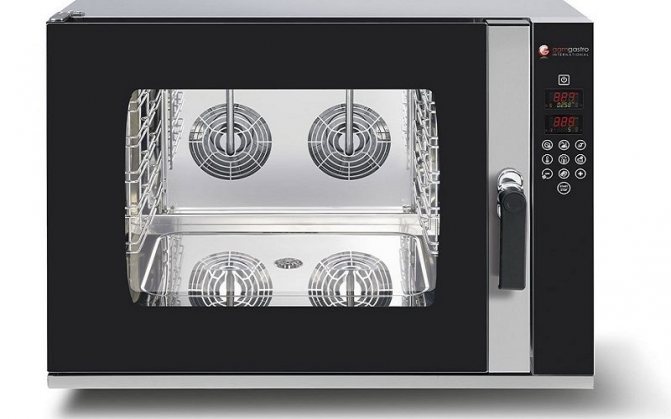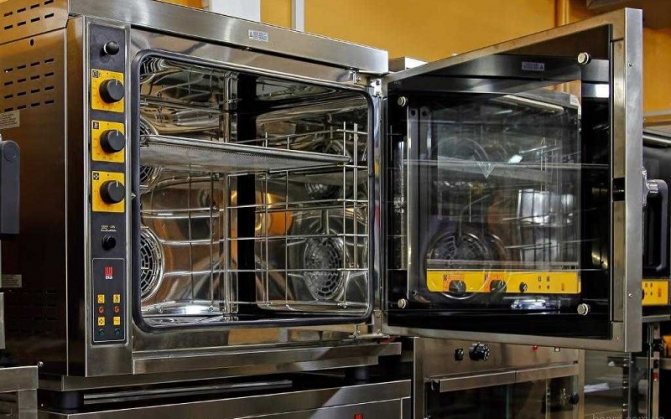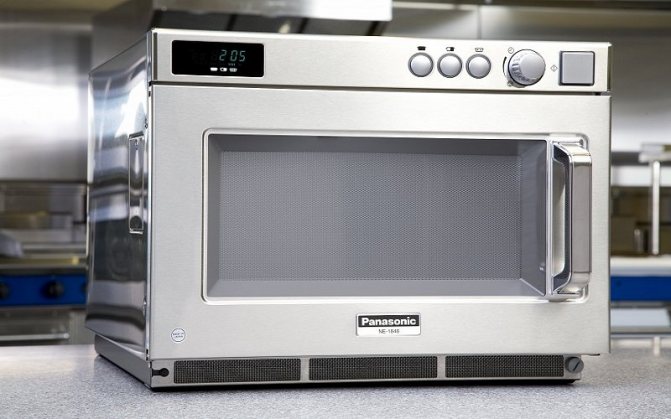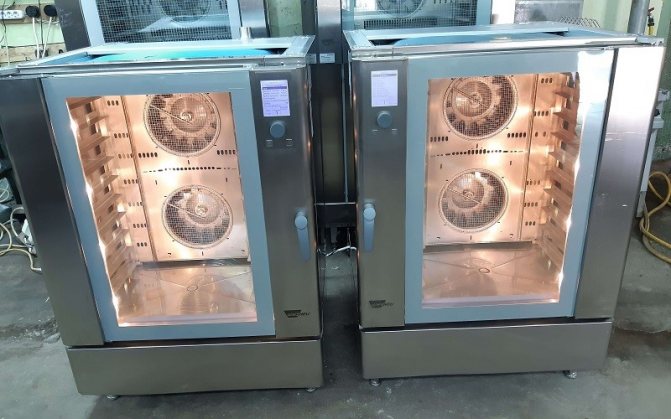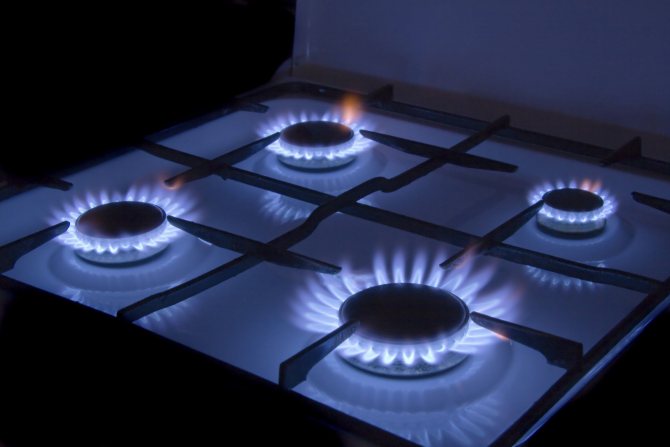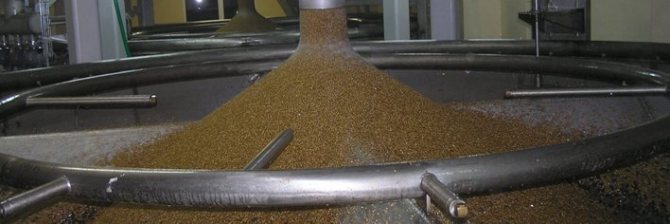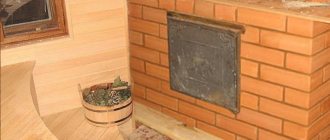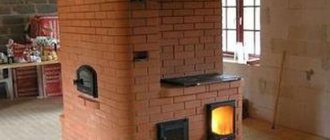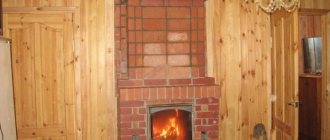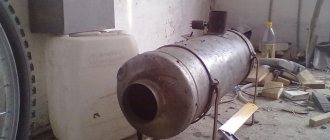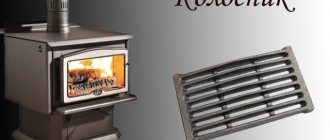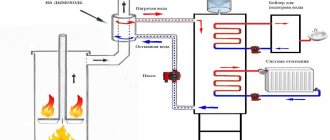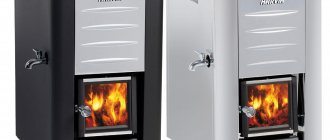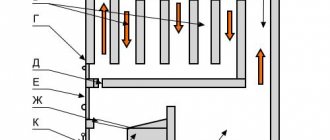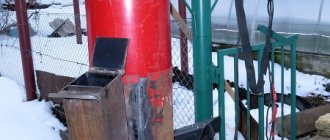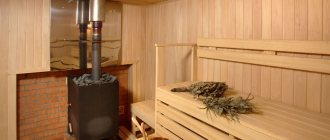Principle of operation
Water circuits are rarely connected to gas stoves. The room is heated directly - with heated air from the stove. The only difference with a solid fuel stove is that it uses natural gas, not firewood.
Advice. It is very easy to install a water circuit with a heat exchanger or a water tank in gas ovens; sometimes a system is connected that allows warm air masses to be removed to adjacent rooms.
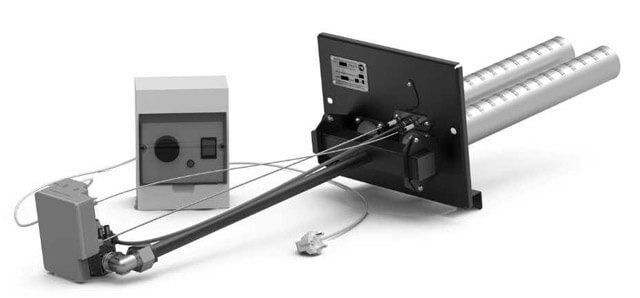
There are options for gas ovens, combined with a solid fuel unit, or powered by electricity. There are universal burners that run on diesel fuel, if the need arises.
Important. All installation, as well as repair work related to gas fuel must be carried out exclusively by representatives of a specialized organization that has the appropriate permission.
What are gas ovens
With the help of gas stoves, households and country houses are heated, however, such devices have gained the greatest popularity during the construction of baths. Most often, for this case, factory-made units are bought, which have a metal case. In this case, you need to choose the right model for power and purpose, taking into account the operating conditions. Brick ovens are also being built.
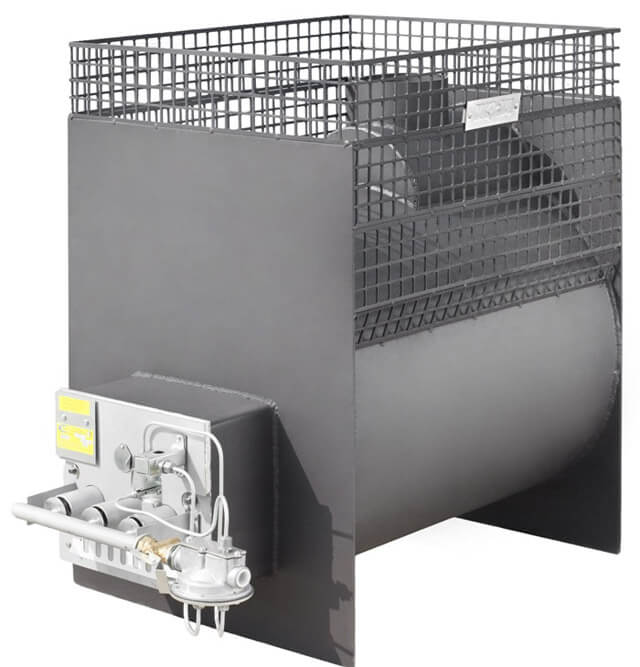

By the method of generating heat, furnaces can be divided into two types:
- With a combustion chamber... Gas enters the heating chamber and heats its walls during combustion.
- Heat exchanger oven... In the construction of these heating units, the gas enters a bent heat-resistant steel tube, which acts as a heat exchanger.
In the second case, the furnaces are additionally equipped with a forced air supply system and the removal of combustion products.
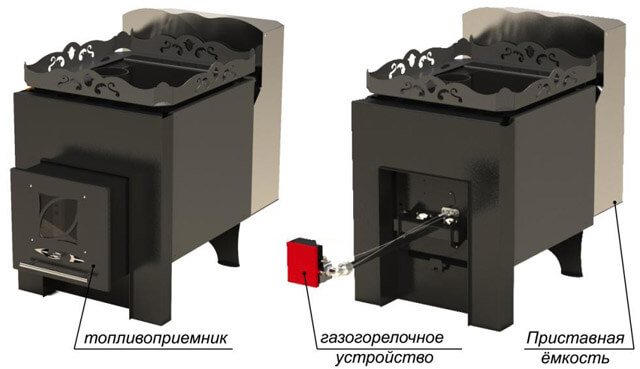

Gas ovens are distinguished by their heat capacity. This indicator depends on the ability of the unit to accumulate heat.
According to this parameter, the furnaces are divided into the following categories:
- Continuous burning furnaces... They have thinner walls that cool down quickly enough. However, there is also a significant plus - just as quickly they warm up the room., Giving off heat outside. To maintain a constant comfortable temperature in the room, the oven must be in the "on" mode. This is a typical summer cottage option. You can come and get warm right away.
- Batch furnace... This is a massive heat-storage structure that is capable of giving off heat even after the gas is shut off. In order to retain heat, the channels and the combustion chamber are finished with clay bricks. It is very convenient to put such stoves in baths. They will warm up the stones in a short time and begin to give off heat for a long time. For heating households, this option is also more acceptable.
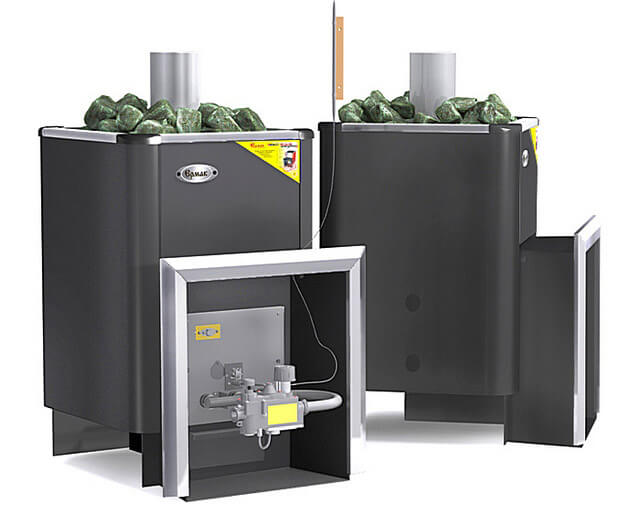

Important. Gas ovens can operate both from a natural gas pipeline and from a cylinder. Furnaces operating on biofuel are widespread. A biofuel fireplace like this is also very effective. For him, you need to improve the design a little.
Features of installing a gas oven in a bath
Such devices in their design practically do not differ from boilers operating on gas.
The main feature is the method of operation. The gas oven is not connected to pipelines. This is a convenient heating system for a house or summer cottage, which allows you to quickly warm up the premises. The liquid coolant cannot freeze in it.
The devices operate on main or cylinder gas. The design of the stove has a body, a firebox, a burner, a heating shield, an automation (a system for cutting off the fuel supply).
The appliance, designed for operation with liquefied gas, can be used to heat a small house (one- or two-story). Gas ovens are not suitable for heating large areas (over 60 m2).
Such heating structures can operate in a continuous or temporary mode.
Gas-burner
This device is one of the most important elements of such a heating system. Burners used in gas ovens have different fuel consumption. To heat a small house or summer cottage, you can use an apparatus that consumes no more than 4 m3 / h.
The burner is a replaceable element. It can be purchased and installed separately. A part of the required power is selected and installed in the existing furnace
In this case, it is necessary to pay attention to the same dimensions of the threaded connection of the burner and the fuel supply source to the heater. The dimensions of the mounting window for this element are 40-55 cm
All gas ovens for heating homes must have certificates confirming their compliance with the state safety and quality standard. If there is no such documentation, then it is better not to purchase such a product.
Choosing a burner
Stove gas burners, which are installed in the stove of a household or a country house, are similar to each other. Like a gas burner for a boiler, it has a combustion chamber (heat exchanger), a housing, a chimney system, channels for heated air and an automatic block.
However, there is one obligatory detail, which in each case has its own characteristics - a gas burner for the stove. It is she who is responsible for the efficiency of the heating unit, power characteristics, economical fuel consumption, safe operation and other important parameters.
In a gas burner, the process of mixing gas with oxygen takes place; it contains a control unit for the fuel combustion process. With it, you can set a certain mode, adjusted to the temperature level that is required for heating. Boilers and stoves often have the same burner models.
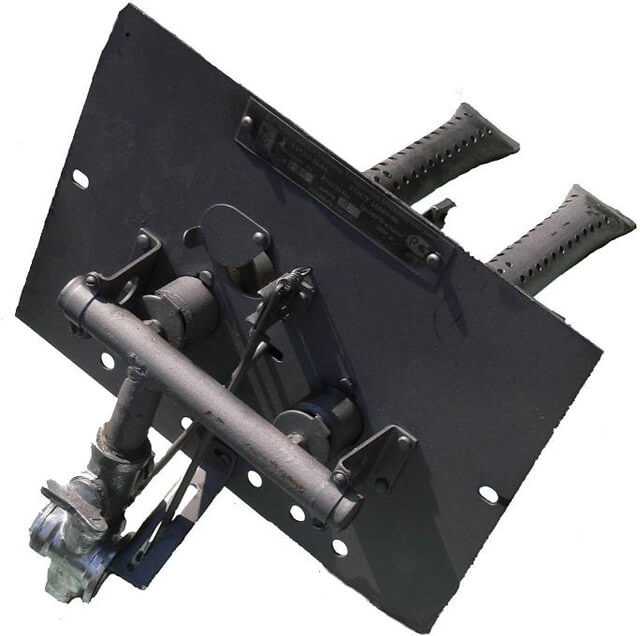

Single-stage atmospheric gas burners for a home stove are not difficult to use, they are easy to install in a heating block. They do not need power supply. Such a burner is placed on the front side, where the combustion door is located.
Important. To select a burner, you need to know its power, it lies in the ability of this model to process a certain amount of fuel in a given period of time.
Gas burners for boilers
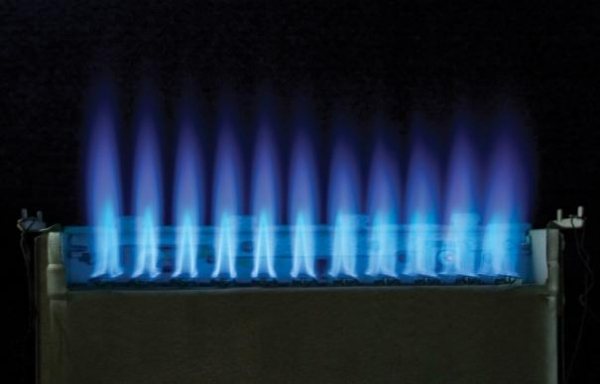

When choosing the type of heating for a private house, it is reasonable to be guided by the reliability and economy of the equipment. The most economical fuel today can be safely called gas... Therefore, when choosing a device for heating a private house, practical owners stop at gas boilers. More about single-circuit representatives: Single-circuit gas boilers: types and characteristics
The selected equipment will serve for a considerable period of time, and for its reliable operation it is necessary to have the skills to select and care for a particular model. If an ordinary user can understand the varieties of the device, then in the matter of gas burners for boilers, knowledge is needed.
What are burners
If a gas burner is considered from the point of view of a method of controlling thermal power, then all models can be divided into the following categories:
- Single stage... In this case, the gas supply (shutdown) occurs automatically, at the signal of the rheostat.
- Two-stage... The burner has a constructive ability to switch to economical mode. This process is automatically regulated.
- Floating burners... The burner power can be changed smoothly, from 10 to 100 percent.
Read also: Tensile strength what is it
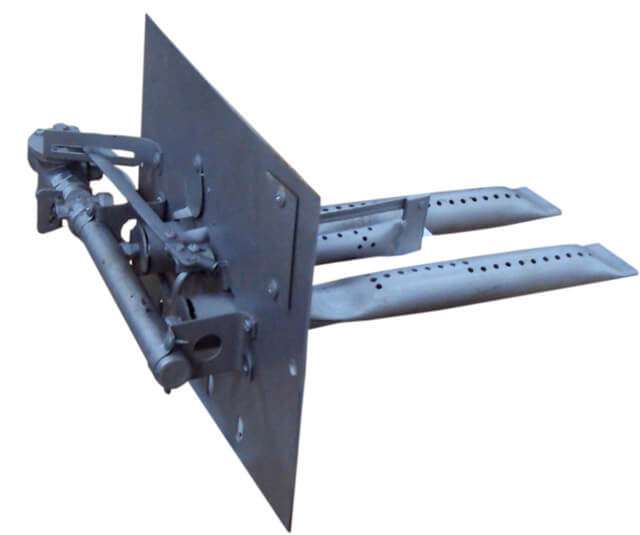

Burners are classified according to the air supply method:
- Atmospheric... In this version, no electricity is needed, the air flows to the burner under the natural action of draft. The efficiency is not very high, no more than 90 percent. It is a simple construction: a pipe with holes where fuel is supplied. It works in open combustion chambers. They can be quickly converted, if necessary, for liquid fuel, the service life of such burners is very long. However, such burners place high safety requirements on themselves.
- Inflatable... They are also called blast or fan burners. This is a rather complex construction. Air is supplied to the burner by a fan, the combustion chamber in this case is closed. The efficiency is over 95 percent. Stoves with such burners do not need bulky chimneys. At the same time, the furnace operates stably even at low gas pressure. However, they generate a lot of noise and are volatile.
- Diffuse kinetic... The air is partially injected into the combustion chamber, the rest is supplied directly to the flame.
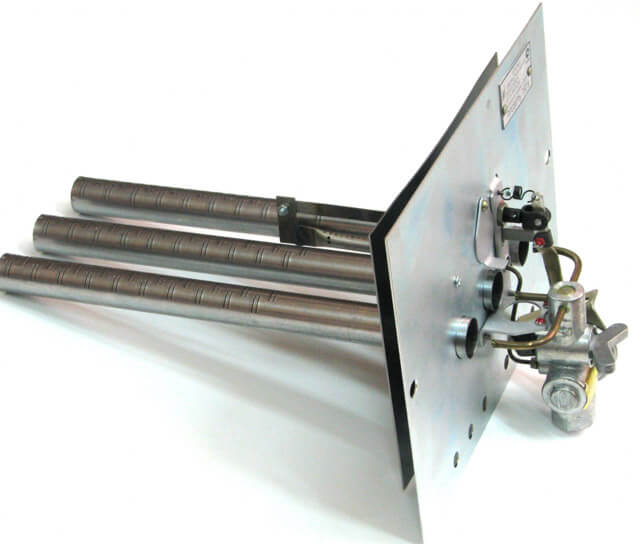

Important. In capital devices with a high heat capacity, with a high furnace power, the burner can overheat. It is recommended to install a model that is resistant to high temperature conditions.
How Do I Pick a Good Device?
The main characteristics of such products are:

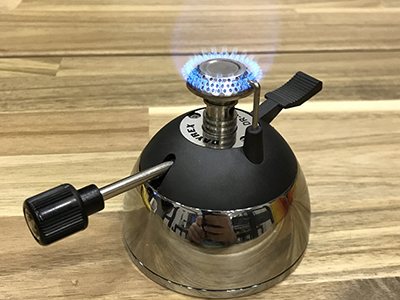
Thermal power.
- Characteristics of the gas to be used in the product.
- The relative length of the flame exiting the burner.
- Calculated gas pressure in the furnace.
- Working setting: the ratio of the theoretical heat output to the lowest.
- Limit adjustment: the ratio of the highest heat output to the lowest.
- Fuel chemical composition.
- The noise level produced by the product.
When choosing a device, you need to keep in mind the following factors:
- Simplicity of design. In this case, the cross-sections of the paths for the passage of gas must be the same and create a minimum resistance to the gas.
- The size of the room. For small rooms, an atmospheric device will suffice, but for larger rooms, the power of such devices may not be enough.
- Product manufacturer. Domestic and foreign (mainly products made in Germany are presented on the market) units have approximately the same cost, but some of these devices are designed for installation in specific types of stoves. For example, the domestic product AGG-15 is suitable for use only in stoves with a long channel for the fuel mixture.
Photo 2. Gas nozzle AGG-26, suitable for furnaces with a long channel.
- Heating device type.
Important! You need to know where the fuel will come from to the heating device: from separate cylinders or from the main pipe. This is also taken into account when installing the stove.
Ignition type
All burners can be divided according to the type of ignition:
- Electronic type... They do not have a constantly working igniter. It requires electricity to work. Electric ignition is one of the most convenient inventions for modern heating units. Thanks to him, the operation of the stoves has become as comfortable as possible. Electric ignition makes it possible to ignite the burner flame safely, without using any available wicks or lighters.
- Piezo ignition burners... No electricity needed.
Sometimes special working conditions are required, for example, burners are placed in the sauna stove, which should distribute the flame well. These are splitters or conventional distribution tubes. This is how kitchen gas ovens work.
The consumption of fuel passing through the burner can vary widely and depend on its design.
Furnace gas nozzles must be safe and energy efficient. This can be achieved if all technical requirements are met. Self-activity in this matter can only harm. Therefore, the installation of gas burners must be carried out by specialists.
Support the project, share with your friends!
1. From sections of cast iron batteries. How many sections, how to seal them, can they be put into the flame from the burners, what is the reliability?
2. Welded structure made of steel pipes or bent pipes. What is the diameter, how many meters, what is the shape, can it be put into the flame from the burners, what is the reliability (will the welds disperse in the flame)?
3. Copper heat exchanger from the old gas column to the flame from the burner or nearby (the column did not work for a day - Savdepovsky heat exchanger, zero) + copper pipe coil. How to seal the joints, how quickly will it burn out, how many meters of the pipe?
Variants of the type - "put the boiler on and don't worry" do not fit - actually calculated - my version is cheaper, and the places for the boiler are only instead of the stove (the latter will have to be removed, and this is additional costs and time.
The budget for the heat exchanger is 1000-1500 UAH.
People, I will be grateful for any advice and morality, otherwise my head will soon burst from uncertainty.
User comments:
So far, there are no user comments for this material. Your comment will be the first!
Only registered users can answer topics and conduct full-fledged communication
All about repair and construction:
Phone for masters: +7
Login via social networks:
Also, you can enter the site using the following social networks (without filling in personal data):
Authorization
Registration on the portal
Feedback
Fill in the required fields in the form below and click the "Submit" button. Try to be as clear and clear as possible about the essence of the issue and the purpose of the appeal. This will speed up the processing of your appeal. After receiving the letter, we will contact you in a way convenient for you, at a convenient time for you. Thank you for your interest in our site.
The burner of a gas boiler converts the chemical energy of the fuel into thermal energy of water, which is supplied to the heating and hot water supply system of the house. Gas burners for heating furnaces are installed in special devices called boilers. The correct choice of the burner device will ensure not only a comfortable living environment in the house, but also its safety.
Control and regulation of injectors and burners
To regulate the operation of a spray-type nozzle device used in heating and heating systems for residential premises, a thermostat is usually used, which is installed inside the apartment, a limiter, which is equipped with a water heating boiler, and a regulator, which is usually placed in the chimney at the outlet of the boiler or stove. These three devices represent the minimum means to ensure the satisfactory operation of the heating device. The room thermostat (thermostat) is used to turn on the heating when the room temperature drops below the set norm, and to turn off the heating after the temperature returns to normal.
Some examples of burner control are shown in fig. 27-30.
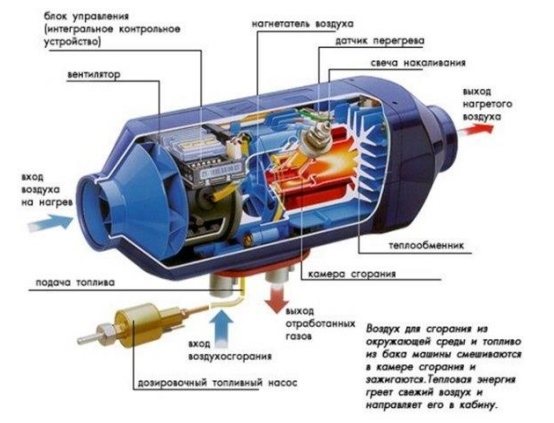

Fig. 27. Using and regulating a liquid burner in a car
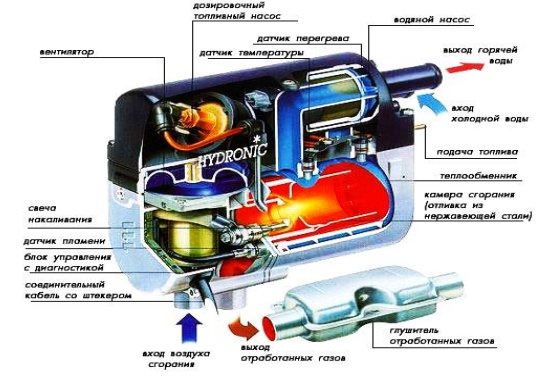

Fig. 28. Using a liquid burner to heat water
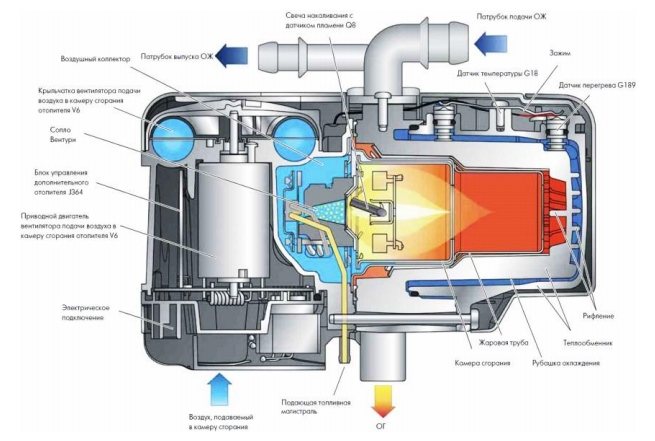

Fig. 29. Example of regulating the operation of a liquid burner
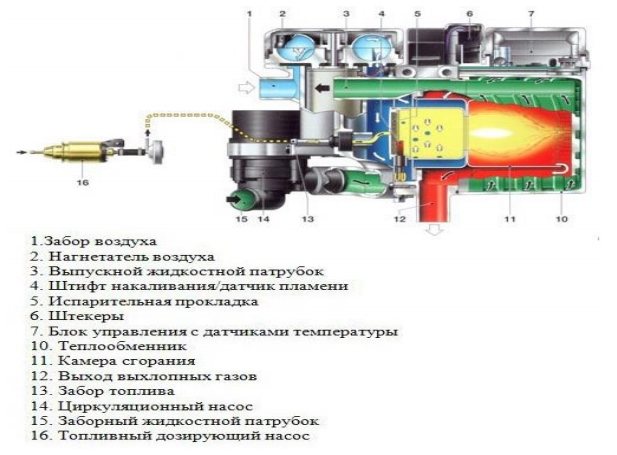

Fig. thirty. Using and regulating the operation of a liquid burner
Combustion process in the boiler
The chemical reaction inside the boiler is a combustion reaction between the oxygen (O2) in the air and the hydrocarbons (CHyOx) of the fuel, which release energy as heat. The combustion process produces water vapor (H2O) and carbon dioxide (CO2), the latter being especially dangerous from the point of view of air pollution and global warming.
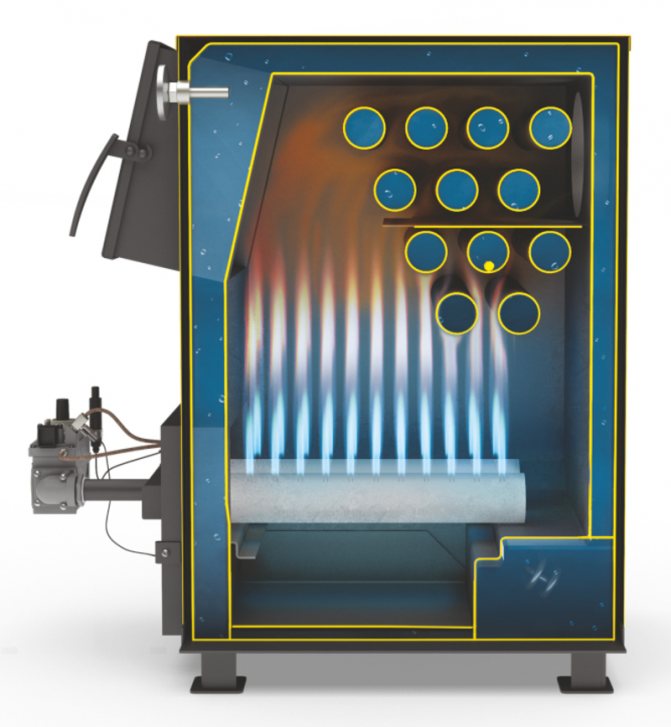

Other combustion products of the nozzle gas can also appear depending on the type of fuel and combustion conditions: nitrogen oxides (NOx) or sulfur (SOx), which are responsible for acid rain. Carbon monoxide (CO), a dangerous poisonous substance, can cause death if inhaled.
Correct adjustment of the device reduces the amount of harmful combustion products. CO2 emissions are reduced when the gas is completely burned out.In order to reduce NOx emissions, it is recommended to use the correct combustion technology, which is ensured by the design of the burner.
What burners are used in wall-hung and floor-standing boilers?
For wall-mounted gas boilers, the most suitable option is automatic or ventilation type burners. Floor-standing gas burners - most often atmospheric, which are included in the standard heating system kit.
Flame regulation
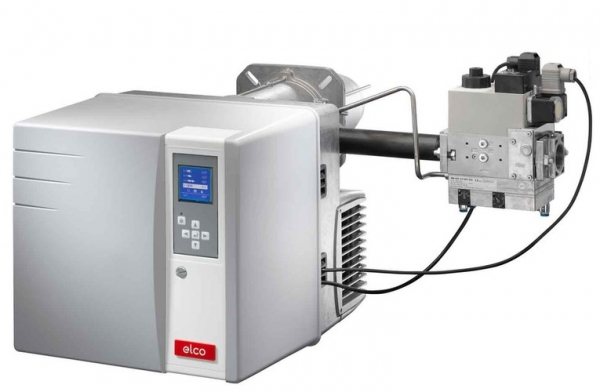

Special low-temperature burners are especially popular nowadays. They have a wide variety of applications - they are excellent for operation in the direct combustion process, are characterized by simplicity and increased reliability.
Depending on the type of flame adjustment, there may be:
- Single stage gas burners are intended to function in one mode only... They are equipped with automatic devices for frequent switching on or off when the device reaches a certain temperature, which significantly reduces their operational life, and also adversely affects the performance of the boiler itself;
- Two-stage burners for a gas boiler are devices that can operate in two different modes or at different power of the fire torch. Switching is usually automatic as a result of a command sent by a special sensor aimed at regulating the temperature regime of the boiler. With this type of burners, you can save fuel by using the device for a sufficiently long operating period;
- Modulating gas burners are considered the most economical as well as functional. They work on the principle that enough smooth regulation of a burning fire torch... They are divided into the following types: with electronic, pneumatic and mechanical flame control systems.
Devices for space heating
They mix fuel and oxygen and, using an ignition device, ensure complete combustion, which takes place in the combustion chamber, and heat is transferred to water through a heat exchanger. Control devices regulate ignition, combustion rate, fuel and air supply, exhaust draft, water temperature, steam and water pressure in the boiler.
The hot water produced by the boiler moves by natural circulation through the internal heating system of the entire building. A heating scheme can include hot water heat exchangers, air conditioning and ventilation units.
Device classification
The industry produces a very large number of gas injectors of various types, purposes and designs, which are strictly classified according to the type of fuel and the method of air supply. Airflow classification:
- Atmospheric - these are burners in which air is supplied in a natural way, it is captured in the Venturi tube by a gas stream according to the injector principle.
- Forced air or impulse burners are equipped with a fan that provides air supply for combustion of the air-fuel mixture and the removal of products resulting from the combustion of the fuel.
Read also: How to connect a digital TV box to a TV
A gas burner for a stove in a house is divided by fuel type:
- Gas for burning gaseous fuels.
- Burner for burning liquid fuel.
Malfunctions and their elimination
The main sign that the nozzle is out of order is blue smoke that comes out of the chimney. In addition, the presence of black soot may be observed. One of the possible reasons is the contamination of the product with components from the composition of the fuel-air mixture.
Can I troubleshoot myself? Ideally, you should call your service representative and inform him of your suspicions.However, if this is not possible, you must perform the following sequence of actions:
- We take out the device from the socket.
- We extract the filter.
- We wash the removed filter, let it dry.
- We return all the parts to their original place.
Please note: rinsing the filter is possible using only non-abrasive detergents.
The principle of operation of the atmospheric burner
Gas, getting into the nozzle of the nozzle, increases its speed and creates a vacuum at the base of the torch, which sucks in part of the combustion air, the so-called primary air, forming a gas-air mixture.
The main air-gas mixture enters a series of holes (circular, inclined, straight) located on one or more tiers of the device. The mixture is ignited with an igniter. The additional air required for combustion, called secondary air, is drawn into the flame by induction due to natural convection.
A homemade gas burner for heating with domestic gas has a primary air percentage of 40 to 50%. All parts of the device (injectors, mixing tubes) structurally ensure stable combustion of fuel without losses. However, this type of burner does not have the ability to manually control the combustion process. The combustion process is rigidly provided by the burner design and fuel parameters.
While the great advantage of boilers equipped with an atmospheric burner (up to 1 MW) is the simplicity of the system, they have major disadvantages:
- no emergency shutdown of the combustion process during the operation of the brick oven in the event of a sudden interruption of the fuel supply;
- excess air;
- poor combustion efficiency;
- significant production of NO x.
Heating furnaces
Heating furnaces designed to heat billets of ferrous and non-ferrous metals for forging, pressing, stamping
taste, upsetting, bending, winding of springs, and furnaces for heat treatment of parts operate in the temperature range from 150 to 1350 ° C.
By design, heating furnaces are divided into chamber, continuous and batch, methodical with two- or three-zone heating, conveyor, spectacle and slot.
Each heating furnace consists of the following main parts: firebox, work space and flues, recuperator, chimney and various accessories.
Chamber furnaces are various in design and are divided into stationary and portable. In stationary furnaces, combustion products are led down into chimneys and then into the chimney. In portable furnaces, combustion projects are diverted upward, under the umbrella and then piped outside the workshop.
Portable ovens are usually small in size. They are easy to operate and repair. They do not need to build foundations and chimneys. In case of repair, the chamber furnace is removed with an overhead crane, and a new one is put in its place. This reduces downtime for major equipment. '
In fig. 1 shows a portable chamber furnace operating on liquid fuel. In the working space 1 of the furnace, nozzles 10 are directed from both sides. The working space is lined with refractory bricks 9. The combustion products are removed through channels 8, which are located at the hearth of the furnace. Combustion products, passing through the recuperator 5, give off part of the heat for heating the air and are removed through the umbrella into the pipeline.The furnace is loaded and unloaded through the working window 7, closed by the shutter 6, the persistent brickwork of the furnace is lined with a heat-insulating layer 4 and reinforced with a metal frame 3, which installs on a stable base 2.
Mechanized and semi-mechanized chamber heating furnaces include furnaces, charging
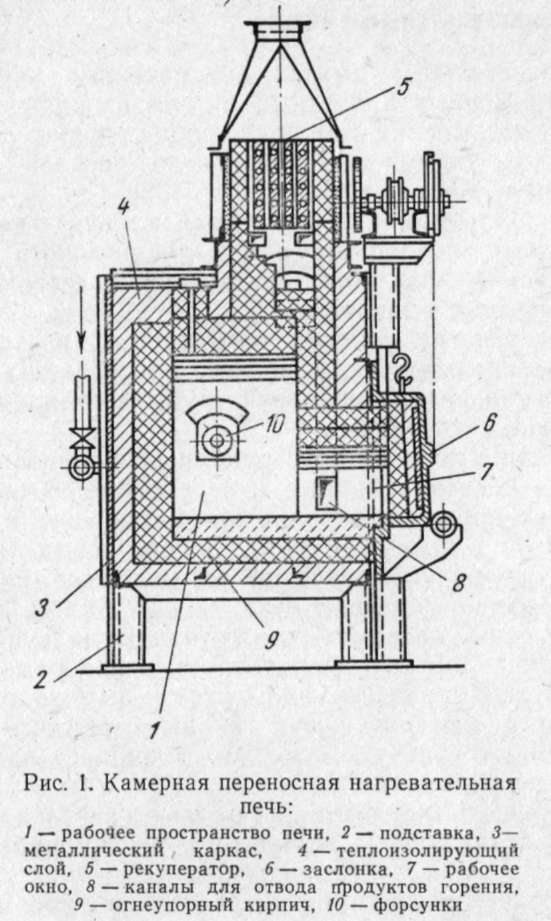

which and unloading from them or moving metal along the hearth of the furnace are carried out using mechanisms.
The rhythm of the dispensing of blanks from the furnace makes it possible to install mechanized chamber furnaces into the production line together with the main equipment. Of all mechanized furnaces, pusher furnaces are the simplest in design and operating conditions.
A pusher forging furnace operating on gas or liquid fuel is shown in Fig. 2. To increase the durability of the masonry, the furnace frame is installed on a rack with spring shock absorbers /, which perceive vibrations and shocks arising from the operation of presses, hammers and other impact machines.
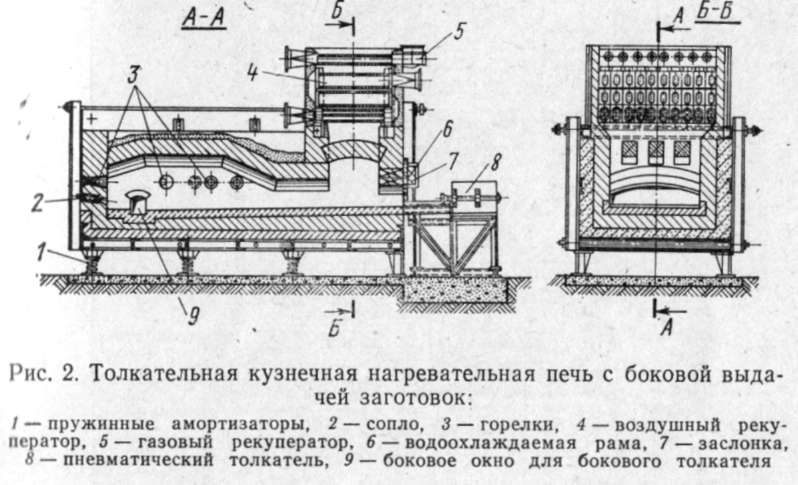

Burners 3 are installed in the working space of the furnace, in which the workpieces are heated. For heating air and gas, 4 air and 5 gas recuperators are installed. Through the nozzle 2, a directed stream of gas is supplied to the surface of the heated metal. The workpieces are fed into the furnace by a pneumatic pusher 8. The side pusher delivers the workpieces from the furnace through the side window 9. The shutter 7 is moved by a lifting mechanism along the water-cooled frame 6.
Spectacle rotary kiln (Fig. 3) is used in the case of heating round billets for heading bolt heads and for pulling off the ends. Such a furnace is a cylindrical fireclay muffle 1 with a wall thickness of 65 mm, in which there are holes 2 with a diameter of up to 40 mm. The muffle together with the hearth rotates on an annular hinged support 3. In the center of the hearth of the furnace there is a gas burner 4. The flue gases, passing through the goggle holes, are heated
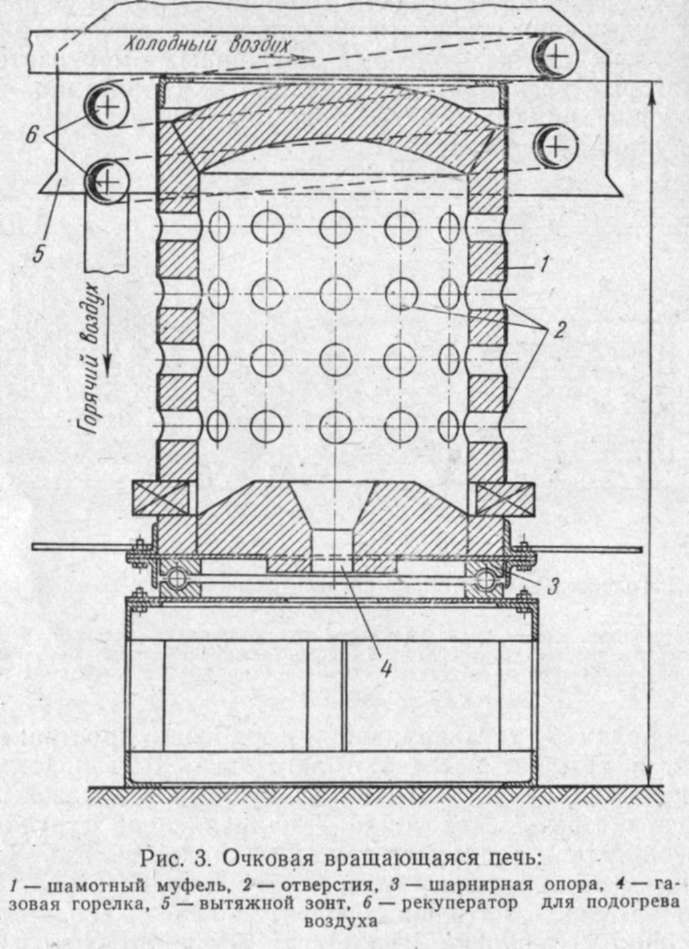

installed workpieces and removed through the exhaust hood into the pipeline.
A recuperator 6 in the form of two turns of a pipe bent into a ring for heating cold air is installed under the umbrella 5 on the path of the exhaust flue gases.
Spectacle furnaces are round and rectangular in design, rotary and fixed (non-rotary). Rectangular rotary kilns are 11 easier to manufacture and larger than rotary spectacle kilns and have only one working window.
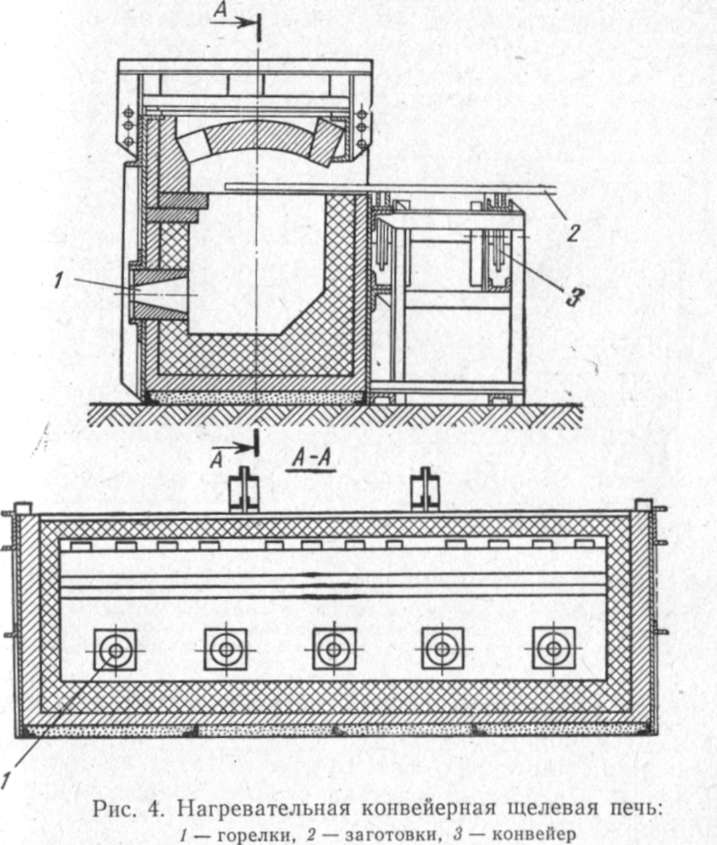

In fig. 4 shows a conveyor slit furnace for heating the ends of a billet. Conveyor 3 is located on the side of the furnace, and blanks 2 are laid horizontally into the conveyor links. The speed of the conveyor ensures that the workpieces are heated to a predetermined temperature in the working space of the furnace. The furnace is equipped with five burners /.
In the furnaces of the presented designs, the metal is heated by an open flame, which leads to the formation of scale on the surface of the workpieces. Non-oxidative heating of workpieces is carried out in special furnaces of batch and continuous operation. Batchless non-oxidizing ovens perform better. These furnaces are used for gas carburizing and annealing of parts, i.e. for heat treatment.
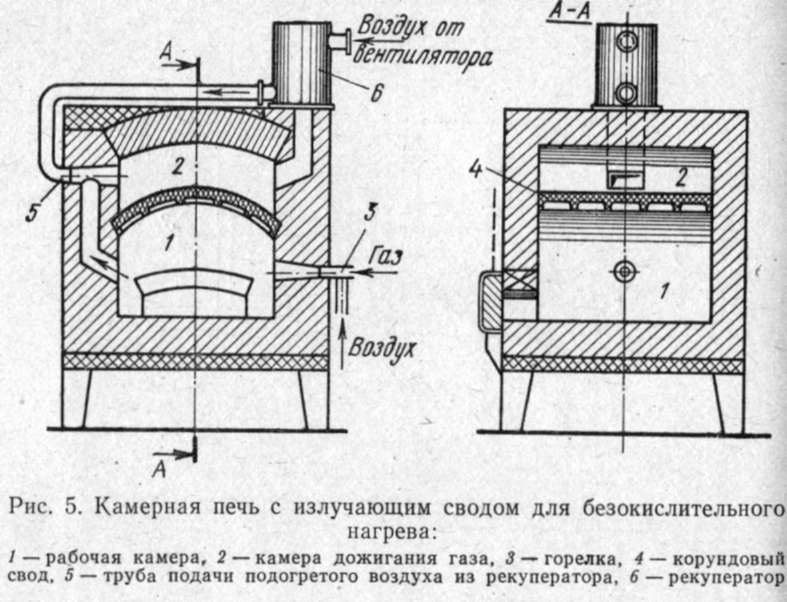

The method of heating metal in a weakly oxidizing atmosphere, obtained as a result of burning natural gas with a lack of air, is being widely introduced. With a large lack of air, the combustion temperature drops sharply.
In fig. 5 shows a furnace for non-oxidizing heating, in which gas is combusted in the working space of the furnace and afterburned in a chamber with an excess of heated air. The gas is burnt in the working chamber / with a lack of air with the help of the burner 3. Combustion products with a temperature of 800-900 ° C enter chamber 2, where they are burned out with an excess of air heated in the recuperator 6 supplied through the pipe 5. The temperature in chamber 2 rises to 1400-1600 ° C. The heat of the chamber 2 is transferred through the thin corundum vault 4 to the working chamber /. Heating of the workpieces is carried out mainly due to the radiation of heat by the roof, and the furnace gases formed in the incomplete combustion chamber protect the workpieces from scale. The composition of the gaseous medium must be controlled during the entire heating process.
Furnaces for non-oxidizing heating are used for heating billets, for hot working by pressure and for heating parts during heat treatment.
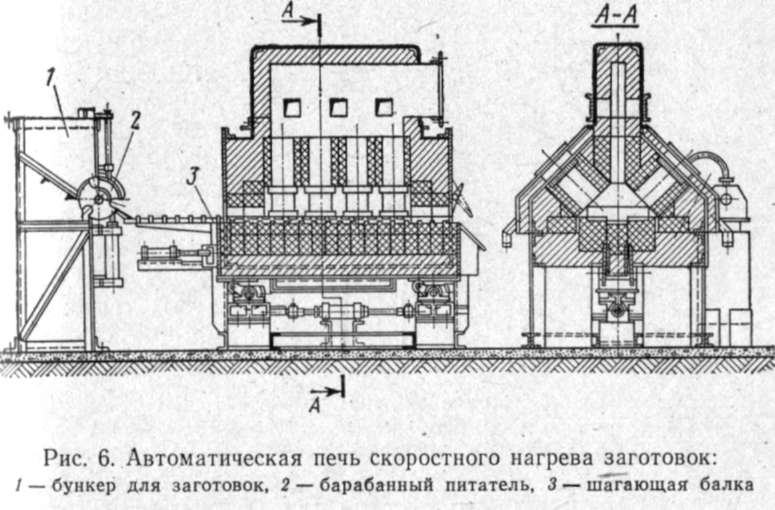

High-speed heating furnaces operate, as a rule, on gaseous fuel. Combustion devices - burners are made of ceramics.
In fig. 6 shows an automatic furnace for high-speed heating of billets. The oven operates in the following order. The workpieces are placed in the hopper /, the drum feeder 2 delivers them one by one to the walking beam 3. The beam moves the workpieces along the working space of the furnace and delivers them to the roller table, which transports the heated workpieces to the press or to the spring coiling machine.
The main indicators that determine the operation of a heating furnace are its productivity and efficiency.
The productivity of the furnace is the amount of metal heated to a given temperature per unit of time. The dimension of the furnace productivity is expressed in kg / h.
The operation of the furnaces is compared according to their specific productivity or the tension of the hearth. The specific productivity of the furnace is the amount of metal heated to a given temperature per 1 m2 of the furnace hearth area for one hour. Consequently, the specific productivity of the furnace is determined by dividing the hourly productivity by the area of the hearth.
The use of heat obtained from fuel combustion is usually presented in the form of a diagram (Fig. 7). The heat A, formed as a result of fuel combustion, is 100% - From this, the amount of heat A \ absorbed by the metal is 10-15%, the heat loss A2 through windows and slots is from 10 to 20%, which depends on the design of the furnace, losses Az from incomplete combustion of fuel are equal to 0.5-1%, the losses of L4 through the masonry of the furnace reach 25% and the most significant heat losses A5 with the exhaust furnace gases reach 45-50%. Thus, only 10-15% of the heat is used to heat the metal, and most (from 85 to 90%) is lost. The ratio of the amount of heat used to heat the metal (a) to the total amount of heat obtained during the combustion of fuel (L) is called the efficiency (efficiency) of the furnace, which is expressed as a percentage:
efficiency = a / A * 100%.
Fuel combustion devices play an important role in the operation of heating furnaces. For solid fuel combustion, furnaces with mechanized fuel supply are used. Solid fuel furnaces are rarely used to heat metal. When burning liquid fuel, nozzles are used, which, according to the operating conditions, are divided into high-pressure nozzles and low-pressure nozzles.
The low pressure nozzle is shown in fig. 8. The rate of atomization of liquid fuel in it. can be kept constant under various operating conditions. Liquid fuel through a pipeline enters a tube 1 with a tapered tip. Air under pressure enters through pipe 5 and rushes through the burner cap 3 at a steep angle to the outgoing stream of fuel oil, spraying and throwing it into the working space of the furnace. Constant spraying speed is achieved by adjusting screw 6. The nozzle works stably, however, the lack of regulation of the correspondence between the hole at the cone tip (oil cone) and the outlet 4 slightly impairs its operation and promotes leakage of liquid fuel. These nozzles are usually used in small ovens.
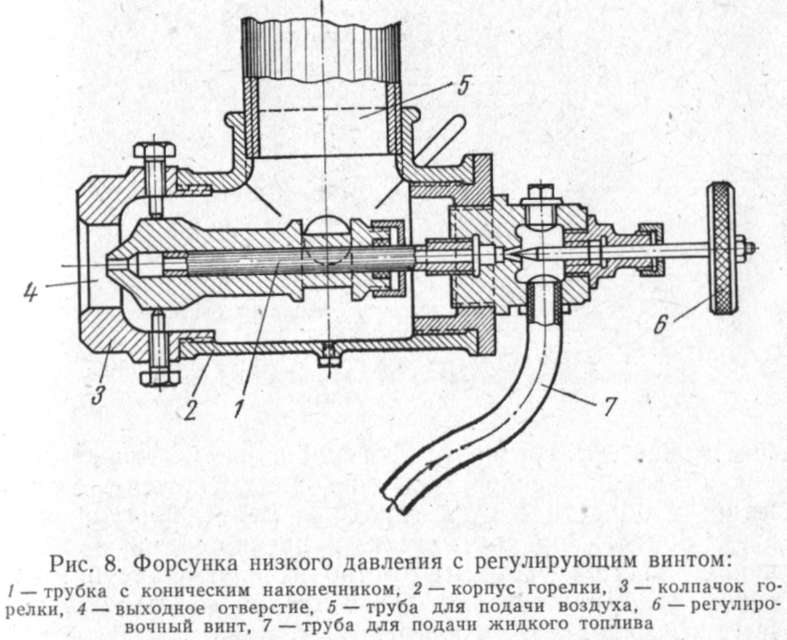

In large and long furnaces, high pressure nozzles are widely used. In fig. 9 shows the nozzle of V.G. Shukhov's system. The nozzle consists of two tubes 1 and 2. Compressed air flows through the outer tube 1, and fuel oil flows through the inner tube 2. In a narrow
At the end (hole 3) of the nozzle, air moves at a very high speed, creating a certain vacuum in the area of the cone of tube 2, fuel oil entering this area is picked up and turns into tiny particles that quickly burn out. High pressure nozzles create a torch up to 4 m long with a sharp high temperature flame.
Since the compressed air obtained from the compressor is expensive, these nozzles are not very economical.Compressed air in the amount of 8-10% of the total amount required for burning fuel oil is used only for atomizing it. The rest of the air required for fuel oil combustion is injected (sucked in) through the nozzle hole in the furnace. Instead of compressed air, steam can be supplied to the nozzle.
Gas burners of two types are also widely used for burning gaseous fuels: low and high pressure.
High pressure burners operate at pressures from 6.87 to 24.5 kN / m2 (700 to 2500 mm H2O) and above. In fig. 10 shows an injection burner with an individual mixer operating on gas at a pressure of 14.7-15.7 kN / m2 (1500-1600 mm of water column). Air is supplied to the burner from the atmosphere. Gas enters the burner through the nozzle 4, and air is injected into the burner mixer 5 through the slots 2 formed between the mixer body 5 and the adjusting washer 3, which is installed on the tube.
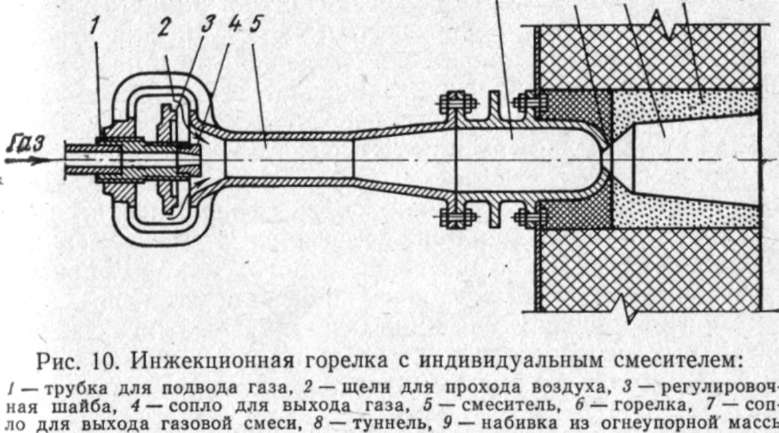

Mixer 5 is a pipe where gas and air are mixed. The gas mixture enters the burner 6, and then rushes through the nozzle 7 into the tunnel 8, where the gas is burned. The tunnel is laid out in the wall of the furnace from the refractory mass 9. As a result of the mixing of gas with air in the area of the mixer, combustion occurs very intensively and without visible flame. Therefore, injection burners are called flameless burners.
The following safety precautions must be observed when lighting heating furnaces fired with liquid and gaseous fuels.
Ignition of oil-fired stoves. The working space of the furnace is blown through the nozzles with compressed air to remove possible accumulation of gases. Then the torch is ignited and introduced into the working space of the furnace into the combustion zone. Turn on the compressed air supply to the nozzle. By means of a nozzle handwheel, a screw is used to regulate the supply of liquid fuel to the working space of the furnace. A burning torch introduced into the combustion zone ignites the combustible mixture of the nozzle. The flame of the torch of the nozzle is regulated by handwheels until stable combustion. The introduced burning torch is transferred to the combustion zone of the next nozzle and the torch of this nozzle is ignited and thus all the nozzles of the furnace are activated.
The ignition of furnaces operating on gaseous fuel is carried out with ignitors in the following order. Through gas burners, the working space of the furnace is blown with compressed air to remove possible accumulation of a combustible mixture. Then gas is supplied to the igniter and ignited. The flame igniter is installed in front of the burner nozzle. The screw turns on the compressed air supply, and then the combustible gas is supplied to the burner. The combustible mixture formed in the working space of the furnace is ignited by the igniter flame, forming a burner torch. In this way, all burners are activated, achieving stable combustion in the working space of the furnace.
In case of violation of the specified rules for ignition of heating furnaces, an explosion of a combustible mixture is possible, dangerous to the life and health of the heater.
Back to the table of contents
For questions about placing orders for the manufacture of springs, contact:
| ICQ consultants: |
| Moscow | St. Petersburg | Voronezh |
| Yekaterinburg | Novosibirsk | Krasnodar |
| Krasnoyarsk | Nizhny Novgorod | Kazan |
| Tolyatti | Volgograd | Ufa |
| Permian | Rostov-on-Don | Samara |
| Tyumen |
© 2015-2018 Spring Coiling Plant LLC. Manufacture and sale of metal springs: torsion springs production, compression springs winding, disc springs. We offer pipe hangers and supports, as well as retaining rings.
Pulse burner design
It has a higher efficiency than natural ones, more efficient and more complex in design. The fuel burner consists mainly of seven elements:
- The fuel pump, it supplies fuel from the tank (liquid fuel) to the boiler and is equipped with a pressure regulator that returns the excess fuel required for combustion.
- A fan, it provides the combustion process with the air necessary for fuel combustion.
- A solenoid valve is a valve that works automatically. It is used to deliver a jet of fuel in sufficient quantity for combustion.
- The nozzles are the central part of the burner. The nozzle allows the fuel to be atomized very finely to help it mix thoroughly with the air to form an air / fuel mixture for combustion.
- Fuel heater, it allows the liquid fuel contained in the tank to be made less viscous to aid combustion. This initial viscosity is related to the storage temperature in the tank as well as the specific characteristics of the fuel.
- Electrodes, they allow you to ignite the gas-air mixture to create the desired flame.
- Combustion head, which consists of two elements. A tip that directs the flame and a reflector held by the flame in the stove.
The operating mode of the burner can be divided sequentially into stages:
- Preignition. Turns on the fan, which allows the engine to run.
- Ignition. Opening of the solenoid valve that directs fuel to the nozzle.
- Ignition. A spark is created to maintain a stable combustion torch.
- Mode of operation. Turning off the igniter after stabilization of the flame.
- Stop. Closing the solenoid valve, turning off the burner and after 15 - 20 minutes of ventilation of the furnace in order to free the combustion space from explosive mixtures, turn off the fan.
Varieties of burners
This design for the furnace is a reliable equipment that is used for long-term operation, it is based on high-quality materials, careful multi-level control, which makes it possible to provide high-quality finished products. The most popular brands on the domestic market are the Mosklimat TERMO oven and fireplace installations. Weishaupt. Giersch. Wester Line. Buderus.
Tags: stove, install, nozzle
«Previous post
Oven nozzle
The oven gas burner is used to burn gaseous fuels such as gas. They are available as atmospheric or pulse burners. When comparing the two systems, especially the blower burners, they ensure very clean and efficient combustion of gas products in all power ranges by precisely controlling the supply of fuel and combustion air.
In modern and compact heaters, today mainly flat burners are used, in which the flame is distributed over several nozzles over a larger area. The operator's hand makes the combustion especially efficient and also cleaner due to the lower temperature. Especially favorable and clean is the so-called catalytic combustion, in which the gas enters into a chemical oxidation reaction on the catalyst surface with oxygen from the air. This process does not require conventional ignition and is characterized by a very low flame temperature.
Making a nozzle with your own hands
Before you start using a home-made product with your own hands, you need to go through the following procedures:
- The burner must pass a quality check at the local Rostekhnadzor office in accordance with the regulations established in the Federal Law on the Safety of Buildings and Structures of 12/30/2009.
- After this check, it is necessary to obtain a certificate from Rostechnadzor about the suitability of the burner for operation.
In order to start making a nozzle, you need the following materials:
- A valve that will serve to regulate the fuel supply by the device. To supply gas to the burner, use the valve installed on the gas source.
- Steel pipe. It is desirable that it has a thickness of up to 2 mm and a length of up to 100 mm.
- Steel cap for making the fuel dispenser. You can also use a blowtorch jet.
- Steel handle.It can be made from a conventional fitting.
- Rubber for handle lining.
- Wire. It will be used for welding.
You will also need the following tools:
- Welding machine.
- Grinder for cutting parts.
For handicraft production, an atmospheric nozzle is preferable due to the simplicity of its design. The procedure is as follows:
- First, the cap is screwed onto the valve. For example, if a standard VK-74 valve is used, then the cap has a tapered thread.
- Then, by cutting the existing steel pipe with a grinder to the required dimensions, the nozzle of the future nozzle is made - its basis.
- Next, the nozzle is welded to the cap using a wire. In this case, the cap and the nozzle should not touch.
- A piezoelectric element is installed, which is needed to activate the device.
After that, the product is ready for installation.
Attention! To install a system for supplying fuel to a stove from a central heating system, special equipment and experience in working with gas systems are required. ... Furnace installation
Installation for oven
When installing the finished unit in the furnace, take into account what materials it is made of:
- If we are talking about a brick stove, then the obvious disadvantage will be the high cost and complexity of such a design, which is assembled only by a specialist. In this case, the nozzle is mounted inside the oven.
- In turn, the installation of the unit in a metal furnace is much easier and can be done without the involvement of specialists. In this case, the nozzle is mounted directly into the stove so that the flame enters the boiler in sufficient quantity to form a fuel mixture.
The gas nozzle - the heart of the stove - must be of high quality and correctly installed. If this unit malfunctions, fuel-related problems may arise, which can lead to irreversible consequences.
Liquid fuel combustion device
These burners are used to burn liquid fuels such as low sulfur fuel oil, diesel fuel or biofuels. Unlike gas, this type of fuel must be atomized to a gaseous state. If this is not done, large drops of fuel oil will enter the combustion chamber.
They will not be able to burn completely, will cause the formation of soot, which will settle on the heat exchanger and reduce the useful heating surface of the boiler. These burners at one time offered a forced combustion process, as blowing burners, whereby the necessary air was mechanically supplied to the combustion point. According to the color of the flame, a distinction is made between the so-called yellow and blue burners.
Read also: Machine tool setter with programmed control etc
While yellow burners spray liquid fuel, blue burners use some of the combustion heat to completely vaporize the fuel oil. This way, less soot is produced and combustion occurs at higher temperatures - hence the blue color.
Since clean combustion always depends on a sufficient throughput and sufficient quantity of liquid fuel, the use of such burners in the home is limited compared to gas burners.
Management and regulation.
To regulate the operation of a spray-type nozzle device used in heating and heating systems for residential premises, a thermostat is usually used, which is installed inside the apartment, a limiter that is equipped with a water heating boiler, and a regulator, which is usually placed in the chimney at the outlet of the boiler or stove. These three devices represent the minimum means to ensure the satisfactory operation of the heating device.
The room thermostat (thermostat) is used to turn on the heating when the air temperature in the room drops below the set norm, and to turn off the heating after the temperature becomes normal.Sometimes the operation of the thermostat is controlled by some kind of software device that sets the economical mode of operation of the heating system.
The limiter ensures that the pressure or temperature in the boiler or in the firebox does not exceed the permissible values. In a steam heating system, the limiter reacts to the maximum permissible pressure value, while in air or water heating systems it reacts to the maximum permissible temperature value.
The system regulator is primarily used to switch the heating system on and off in accordance with control commands from the room thermostat or limiter. It also ensures the safety of the system by shutting it down in case of any problems. For example, if the burner does not light up, the regulator will shut down the unit. After that, it will be possible to turn on the system only manually by pressing the button or turning the lever that controls the burner. Likewise, if the combustion flame goes beyond the limits corresponding to normal operation, the regulator will turn off the burner, and it can only be turned on again manually. These precautions may never be needed, but they are of utmost importance to ensure trouble-free operation of the system. Thus, the system regulator is an automatic device that guarantees the safety of its operation: until the conditions for normal operation of the burner are ensured, it will not be able to start working.
Capillary and capsule burners are designed for individual use and are rarely equipped with automatic controls. Their switching on and off, as well as the regulation of thermal power, are also carried out manually. Many tank-type burners also do not have an automatic regulation system, but some more powerful ones, especially those equipped with air blowers, have a complete control and regulation system, including an automatic ignition device.
Gas equipment security system
The safety system allows continuous monitoring of the burner flame. This control is provided either by a photosensitive photocell created by a flame or by a photocell that is sensitive to light radiation. The system automatically warns the user in the following cases:
- the flame does not appear when fuel is supplied;
- torch breakage during combustion;
- the burner does not work.
Thanks to this control system, the boiler does not have unburned fuel, which can cause an explosion of the gas-air mixture in the boiler furnace. To ensure reliable and trouble-free operation of the boiler, the burner must perform the following functions:
- fuel ignition;
- automatic feeding and processing of fuel;
- combustion air supply;
- completeness of fuel combustion;
- power regulation.
Trouble-shooting
Having a boiler at home brings many advantages, but it also has a number of disadvantages, and the user does not always know how to do the right thing. Boiler faults are common to many types. It is important to determine the cause of these faults in a timely manner before calling the emergency service. List of the most common and most likely faults.
First of all, if the boiler does not start, you need to check the circuit nodes:
- mains voltage;
- malfunction of the switch or engine fan of the boiler;
- damaged boiler cables;
- false contacts of automation or commissioning equipment;
- the presence of water, whether the gas boiler is powered up to the minimum required mark specified by the equipment manufacturer.
If the boiler failure is not caused by any of these problems, the following procedure is to be followed:
- Pay attention to boiler noises, as these are often the first witnesses to destruction.They can also be due to hot water that has got inside the firebox or due to the presence of air in the heating system due to clogged air ducts.
- Pipe rupture. It usually occurs due to problems with a jammed boiler feed valve, various scale-forming deposits in the boiler, or a malfunction of the condensate drainage systems.
- Failures due to exceeding the pressure and temperature readings, their corresponding sensors can cause triggering, for example, due to a breakdown of the thermometer or, conversely, which is especially dangerous as a result of real overheating of the boiler.
- Heating circuits do not work, possibly poor quality of the feed water and scale formation in the boiler pipes.
- A problem with the burner occurs (loss of flame, accumulation of gas causes detonation and explosion).
In the event of some of these problems, mainly pressure or temperature, the monitor of the boiler monitoring device displays an error message, then the system shuts down and automatically restarts. If the problem persists after restarting, it is best to call a technician to fix the problem. It should be noted, however, that most of these failures are avoidable.
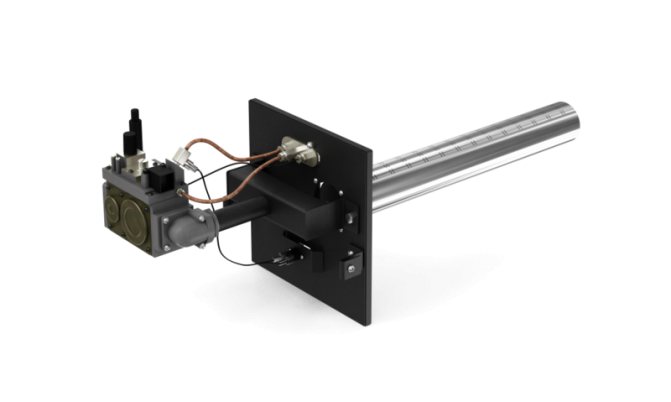

The best prevention is inspection, maintenance and annual cleaning of the boiler, usually carried out by a specialist. This will prevent the pipes from clogging and bursting. Prevention is better than recovery, and a simple annual inspection will keep equipment and the health of users safe from potential disasters.
Applications
Areas of application for LECHLER injectors
The German company LECHLER GmbH produces water nozzles for almost all industries. LECHLER precision nozzles are perfect for the task wherever you need to spray the right amount of liquid precisely, on time and in the right place.
MAIN APPLICATIONS OF LECHLER NOZZLES:
Food and beverage industry (milk, beer, juice, water)
- nozzles for washing, pre-preparation of products, semi-finished products
- injectors
for washing containers (boxes, containers, kegs, bottles, etc.) - injectors
for washing products (vegetables, fruits, etc.) - injectors
for washing equipment, containers, CIP (CIP) washing - injectors
for air humidification, products - injectors
for technological production processes - injectors
for washing containers, vats, 19 l bottles - injectors
for the production of sausages (cooking, smoking) - injectors
for spraying sausages (intensive cooling) - injectors
for defrosting - injectors
for airborne cooling - injectors
for applying, dispensing coatings and reagents - injectors
for blanching - injectors
for glazing seafood (shrimp) - injectors
for soaking malting barley - injectors
for irrigation of malt boxes - injectors
for filling processes, packaging - injectors
for aseptic filling - injectors
for sterilization - injectors
for tunnel pasteurization - injectors
for lubrication and cooling of conveyor belts - injectors
for drying, blowing off, blowing off - injectors
for disinfection and hygiene - injectors
for sanitary inspection rooms for personnel - injectors
for disinfection of hands, shoes - injectors
for sanitary inspection rooms for vehicles - injectors
for disinfection and treatment of equipment and inventory
Chemical blast preparation of the surface before painting
- injectors for the automotive industry
- injectors
for preparing bodies for painting (degreasing, phosphating, washing) - injectors
for body preservation - injectors
for washing parts, assemblies, units - injectors
for lubrication, cooling of cutting tools - injectors
for checking bodies for leaks (sprinkler chambers) - injectors
to simulate rain in aquaplaning tests - injectors
for testing for corrosion resistance (salt chambers) - injectors
for automatic car wash systems - injectors
for prewash - injectors
for the main sink - injectors
for washing rims - injectors
for waxing - injectors
for rinsing - injectors
for lines for surface preparation before painting - injectors
for pre-washing and rinsing - injectors
for jet cleaning - injectors
for degreasing - injectors
to activate - injectors
for phosphating - injectors
for passivation - injectors
for final rinsing - injectors
for chromating - injectors
for rinsing with demineralized water - injectors
for mixing solutions (eductors, ejectors) - injectors
for blowing and dust removal - injectors
for drying - injectors
for the production of printed circuit boards and electronic components - injectors
for alkaline and acid etching - injectors
for cleaning printed circuit boards - injectors
for moistening and washing silicon wafers - injectors
for washing parts, assemblies, units - injectors
for piston cleaning - injectors
for washing oil pallets - injectors
for washing and rinsing in professional dishwashing systems - injectors
for washing and rinsing dishes - injectors
for cleaning conveyor belts - injectors
for washing frames, trolleys
Chemical industry
- injectors
for washing, preliminary preparation of products - washing heads
for washing tanks, reactors - washing heads
for washing storage facilities, tanks - injectors
for washing out sludge and bottom sediments - injectors
for washing centrifuges - injectors
for auxiliary processes in chemical plants - injectors
for air cooling - injectors
for air humidification, product - injectors
for cooling refrigerators, air conditioners, condensers and heat exchangers - injectors
for fire safety of cylindrical and spherical storages - injectors
for cooling and cleaning gases - injectors
for defoaming - injectors
for dust suppression - injectors
for chemical processes (absorption, adsorption, adiabatics, etc.) - injectors
for spraying reagents - injectors
for injection in injection units into the pipeline - injectors
for packed absorption columns - injectors
for Venturi scrubbers - injectors
for spray drying
In many other industries
- mining nozzles
- nozzles for dust suppression in mining
- nozzles for cooling the cutting tools of roadheaders
- nozzles for dust suppression systems in places of overload
- nozzles for applying binder to cargo and anti-caking agent in gondola cars
- nozzles for the nuclear industry
- nozzles for the sprinkler system of the containment of a nuclear reactor
- nozzles for emergency injection of coolant into the pressure compensator of a nuclear reactor
- nozzles for spraying in spray pools of nuclear power plants
- nozzles for the pulp and paper industry
- nozzles for water jet cutting and bevel cutting
- paper web wetting nozzles
- nozzles for cleaning and washing screens, filters
- nozzles for coating paste
- nozzles for the pharmaceutical industry
- nozzles for pelleting tablets in pelleting boilers
- nozzles for stratified pelletizing
- nozzles for moistening the mixture with a binder solution
- globulation nozzles
- granulation nozzles
- spray drying nozzles
- nozzles for the sugar industry
- beet washing nozzles
- nozzles for washing screens, filters
- centrifuge auger spray nozzles
- nozzles for the confectionery, bakery industry
- nozzles for greasing dough cutters
- nozzles for watering bread at the exit from the oven
- coating nozzles
- nozzles for the production of building materials
- nozzles for applying a binder in the production of mineral wool
- nozzles for applying lubricant to molds in the production of concrete products
- nozzles for cooling bitumen in the production of roofing material
- nozzles for wetting the edge of the board in the production of drywall
- blow-off nozzles after cutting in the production of aerated concrete
- nozzles for air humidification in drying chambers in woodworking
- nozzles for the production of animal feed, compound feed
- nozzles for spraying oils, additives
- nozzles for spraying enzymes, vitamins
- shell nozzles
- nozzles for road equipment, transport
- nozzles for irrigation of rollers of road machinery
- nozzles for small utility vehicles
- nozzles for washing railway bogies
- nozzles for poultry farms
- nozzles for air-drop cooling of carcasses
- nozzles for disinfection systems
- nozzles for humidifying air in poultry houses
- nozzles for washing poultry and eggs
- egg powder spray drying nozzles
- nozzles for cooling plastic pipes after extrusion in jet cooling tanks
- leaching nozzles for vegetable oil production
- artificial snow nozzles for snow cannons
- nozzles for snow melting plants
- nozzles for glass cleaning in the production of glass units
- nozzles for cooling rubber sheets in tread units in the production of tires
- nozzles for checking building facades and glass units for tightness
- water curtain nozzles in smoke generators
- nozzles for spark extinguishing in hydro filters of barbecues, grill ovens
- nozzles for greenhouses for air humidification, for blowing off, blowing off
- laundry nozzles for professional washing machines
In addition to the main applications mentioned above, I would like to share with you the unusual applications of LECHLER injectors. NON-STANDARD LECHLER NOZZLE APPLICATIONS
- nozzles for simulating rain at the performances of the State Academic Bolshoi Theater of Russia
- nozzles for simulating rain at the Teatrium productions on Serpukhovka under the direction of Teresa Durova
- nozzles for simulating rain and splashing in 5D cinemas
- foam nozzles for foam parties
- nozzles for cooling in the bath (water curtain at the outlet of the steam room)
The most efficient devices of 2018
The most efficient certified boilers and gas burners this year:
- Bosch Greenstar series. The boiler is small, very quiet, environmentally friendly and uses an economical condensing technology providing an AFUE rating of 95%. Greenstar is available in two models - combi for space and pointless water heating or space heating, which can be used with DHW tanks. It is equipped with a heat exchanger with a 5 year warranty.
- Bradford White Brutus Elite series. The boiler with 95% efficiency has a stainless steel multi-pass condensing heat exchanger with an improved modulation system. Innovative design features make Brute Elite easy to install in both new and existing heating systems.
- Bradford White Brute Elite 125 Series. Customizable combi-based models for heating only, 95% efficient with combi, providing heating and hot water from a single installation. Requires only one gas connection, one ventilation system and built-in expansion tank and boiler pump, has good accessibility for repairs.
- Buderus GB142 series. Condensing gas boiler. Utilizing state of the art condensation technology with 95% AFUE, the Boer Buderus GB142 wall mounted condenser maximizes the heating value of each m3 of natural gas or LPG.
- Boiler Alpine Series. It is a natural or liquefied gas condensing hot water boiler with a stainless steel heat exchanger. Equipped with Sage2 boiler control system. 1 TM, which supports multiple firing speeds, is also equipped with an external reset and touch interface.
- Carrier BMW Performance Series. 95% AFUE. Stainless steel.The modulating condensing boiler is equipped with a unique vertically oriented stainless steel heat exchanger, a ratio of 5 to 1, a compact design with low weight, a compact wall mount, primary and secondary piping, with a 15 year warranty.
Having familiarized yourself with the device and the principle of operation of gas burners and popular models, you can easily choose exactly what suits your needs.

